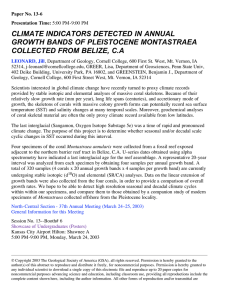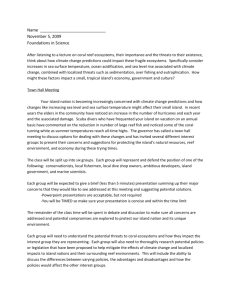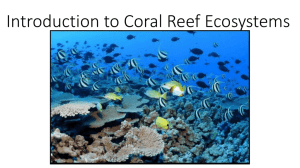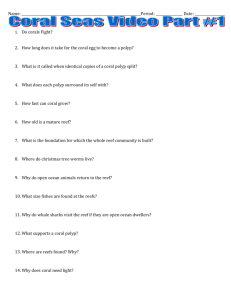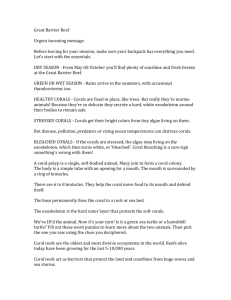Coral Reefs and Lagoons
advertisement
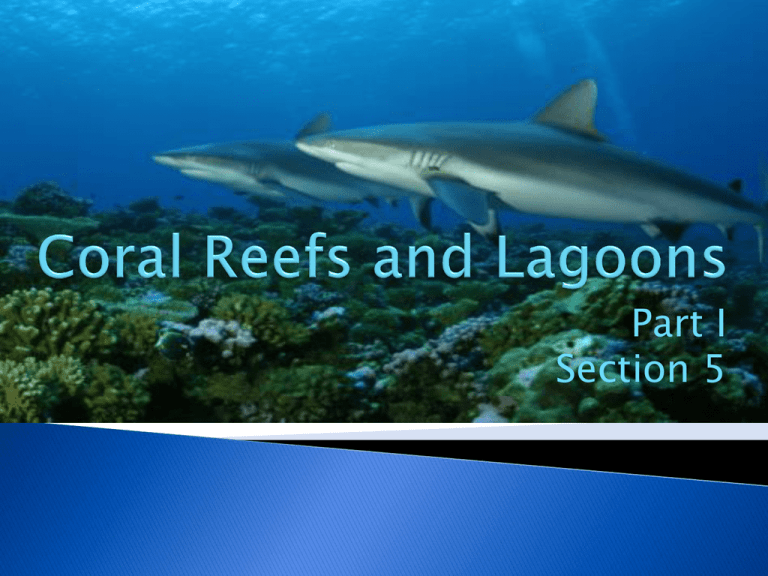
Part I Section 5 Invertebrate marine animal A polyp that begins to form an exoskeleton ◦ CO2 & Ca in the water to make calcium carbonate (CaCO3) aka limestone Sessile – immobile Form colonies Coral atolls 1st proposed by Charles Darwin ◦ HMS Beagle (Nov 1835 – Apr 1836) Supported and modified by 2 geologists ◦ James Daly ◦ Reginald Dana 1. Oceanic volcano emerges from sea surface and forms an island ◦ Colonized by reef-building corals 2. Growth of corals forms a fringing reef around the island ◦ Fringing reef – coral structure attached to the mainland or continental islands Island begins to sink slowly Coral growth continues 3. Island continues to sink Barrier reef forms with lagoon around reef and island ◦ Barrier reef - reef separated from a mainland or island shore by a deep channel or lagoon 4. Island eventually disappears below sea surface Atoll - consists of a ring of small islands Shallow lagoon in center Fringing reef can take 10,000 years to form Atolls up to 30 my Coral – tan and purple Data from deep drilling on coral atolls ◦ Bikini Atoll (Pacific Ocean) ◦ As depth of corals increased, age of corals also increased ◦ Fossil corals dated 50 myo and found 1200 m deep Grown on underlying volcanic rock ◦ Shallow corals found at deep depths! Darwin (1842) produced 1st map of distribution of corals 3 main types: ◦ Fringing barrier reefs, barrier reefs, atolls Conditions required: ◦ Temperature range =16⁰C – 35 ⁰C Optimum range = 23 ⁰C - 25 ⁰C ◦ Water clarity Clear water (less turbid) without silt Silt reduces light penetration which inhibits photosynthesis of symbiotic zooxanthellae in coral tissues (90% nutrients provided) Depth – rapid growth occurs within 20 m from surface ◦ Salinity ◦ Substrate – surface on which plant/animals live Basaltic rocks of seamounts http://m.youtube.com/#/watch?feature=yout u.be&v=35ilnGM9EnU&desktop_uri=%2Fwatc h%3Fv%3D35ilnGM9EnU%26feature%3Dyoutu. be What’s going on here? Shoreline protection from erosion ◦ Dissipates/absorbs energy of waves Benefits include protection of ◦ Coastal properties ◦ Ecosystems ◦ Costs to provide breakwaters – constructed structures for protection from erosion ◦ Anchorage of boats Coral Gardens Fiji (Pacific Ocean) Egypt (Red Sea) Baja Due Friday! Read Marine Biology book pages 10-1 ◦ Answer question 1 AND write bolded words with definitions! ◦ Dropbox it in complete sentence(s) Your NEW Oceanography textbooks are in!!!!!


